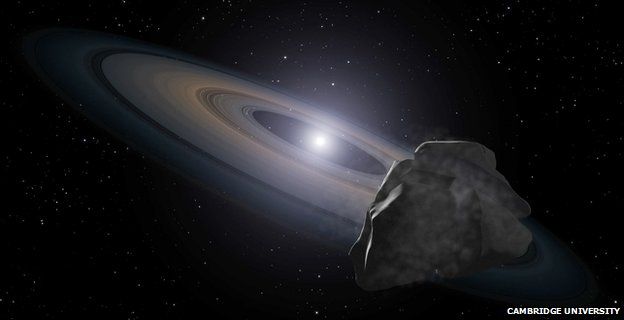'Dirty' stars hint at Sun's future
- Published

Scientists have studied two dead stars that give us a glimpse, they say, of what our Solar System might look like a few billion years from now.
Our Sun will expand outwards when its nuclear fuel runs low and will ultimately blow off its outer layers.
Some of the inner planets will be consumed in the process and asteroids will be thrown out of their orbits.
A Cambridge-led team says it has seen evidence for this big upheaval in the atmospheres of the two burnt-out stars.
And the researchers believe their study has also given them some further insight on where planets can exist in our Milky Way Galaxy.
Dr Jay Farihi: "We see silicon and low levels of carbon in these stars"
The pair of dead stars resides in the Hyades cluster, in the Constellation Taurus, about 150 light-years from Earth. They are so-called white dwarfs - the exhausted cores of average-size stars not unlike our Sun.
The astronomers used the Hubble Space Telescope to probe these two remnants, deciphering their chemistry with the observatory's powerful Cosmic Origins Spectrograph.
This showed the dwarfs to be "polluted" with silicon - the element found in the rocky material that makes up the Earth, the other inner planets in our Solar System, and its asteroids.
It is an indication that rock is falling on to the dead stars, their gravity likely shredding the material and spreading it out into a thin disc as it gets pulled ever closer.
Rocky river
"Stuff must be falling on to [each] star at a very high rate," explained Dr Jay Farihi of Cambridge's Institute of Astronomy.
"We can calculate the number of grams per second. That turns out to be something like a small river's worth of material.
"And based on the whole phenomenon of polluted white dwarfs and what we've learnt in the last few years, we know that there's a disc of material that must be feeding the star's atmosphere with this silicon-rich material," he told BBC News.
"That disc has to come from some disrupted, torn-apart planetesimal. The easiest way to describe it is a modest to large-sized asteroid."
Computer modelling suggests that as ageing stars throw off their outer layers and lose mass to become a dwarf, they destabilise the environment around them.
It becomes gravitationally perturbed, with any big planets still orbiting the dead star then nudging smaller rocks in all directions - many of them towards the dwarf.
Hubble's Hyades observations are very probably showing us this process in action. And it is a vision of what is to come for our own Sun.
In just a few billion years from now, it will use up all of its hydrogen fuel and will swell to become a red giant. Finally, it will dump a large proportion of its gaseous mass to leave a hot, compact and faintly glowing ember.
It also should be pulling in rocks that get too close, gravitationally pulverising them into a thin disc that gradually and continually dopes the remnant atmosphere with silicon.
Planet construction
Clusters like Hyades are places where many stars are born and live relatively close by to each other. But they are also locations where very few planets have thus far been detected.
To date, of the roughly 800 planets catalogued beyond our Solar System, only four are known to orbit stars in a cluster. That may be because these places are very energetic, which makes it difficult to discern orbiting planets using our current observation techniques.
What this latest research implies, however, is that stars in clusters almost certainly do have planets.
"The body responsible for [the silicon pollution] we see must have been an asteroid about 50-100km in size," Dr Farihi told the BBC's Material World programme on Radio 4.
"Asteroids or big rocks are really the building blocks of planets, so the fact that we're seeing giant rocks at these stars means that terrestrial planets were built during the stars' energy-producing lifetime.
"The question of whether they retain those planets to this day is a little bit more tricky. I would venture to say 'yes', because we need large planets to push these rocks around so that they can get close to the star and pollute its atmosphere."
Dr Farihi's team reports its work in the Monthly Notices of the Royal Astronomical Society.
Jonathan.Amos-INTERNET@bbc.co.uk and follow me on Twitter: @BBCAmos
- Published20 February 2013
- Published21 December 2011
- Published20 April 2009